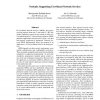Free Online Productivity Tools
i2Speak
i2Symbol
i2OCR
iTex2Img
iWeb2Print
iWeb2Shot
i2Type
iPdf2Split
iPdf2Merge
i2Bopomofo
i2Arabic
i2Style
i2Image
i2PDF
iLatex2Rtf
Sci2ools
USS
2008
2008
NetAuth: Supporting User-Based Network Services
In User-Based Network Services (UBNS), the process servicing requests from user U runs under U's ID. This enables (operating system) access controls to tailor service authorization to U. Like privilege separation, UBNS partitions applications into processes in such a way that each process' permission is minimized. However, because UBNS fundamentally affects the structure of an application, it is best performed early in the design process. UBNS depends on other security mechanisms, most notably authentication and cryptographic protections. These seemingly straightforward needs add considerable complexity to application programming. To avoid this complexity, programmers regularly ignore security issues at the start of program construction. However, after the application is constructed, UBNS is difficult to apply since it would require significant structural changes to the application code. This paper describes easy-to-use security mechanisms supporting UBNS, and thus significa...
Easy-to-use Security Mechanisms | Operating System | Process Servicing Requests | Security Mechanisms | USS 2008 |
| Added | 02 Oct 2010 |
| Updated | 02 Oct 2010 |
| Type | Conference |
| Year | 2008 |
| Where | USS |
| Authors | Manigandan Radhakrishnan, Jon A. Solworth |
Comments (0)

